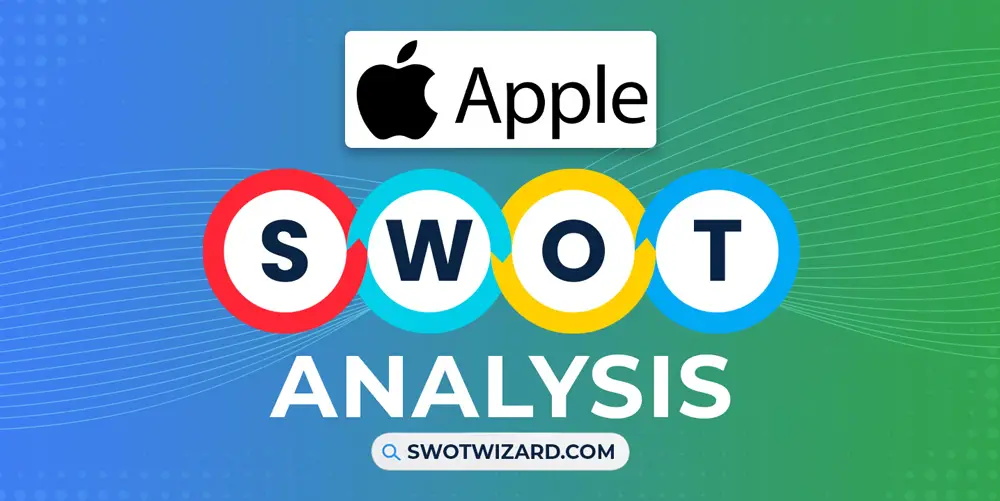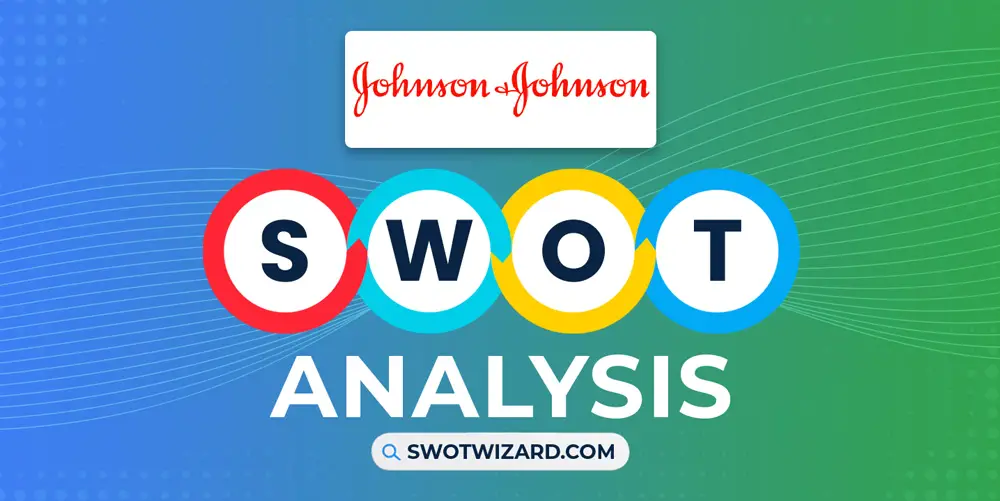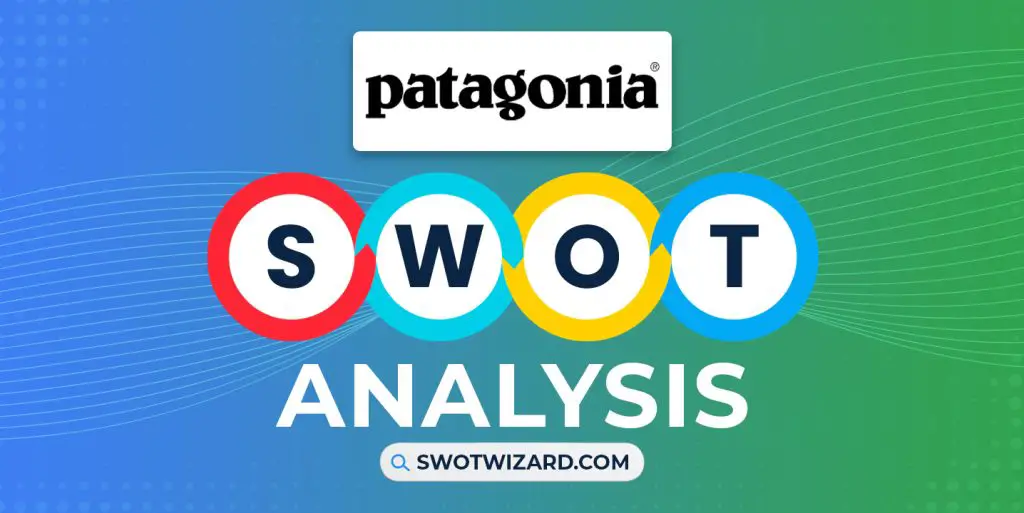Aldi was the 1st to axe customer experience as an expense and shocked competitors with its action. By 2023, its aggressive cost-cutting measures have helped it grow over 10,000 stores worldwide. Its supply chain is a lesson in weaponizing cost-cutting successfully, and we’ll break it down here with the Aldi SWOT analysis.
Aldi: Company Overview
| Company | Volkswagen |
| Industry | Retail |
| Founded | 10 July, 1946 |
| Founders | Karl and Theo Albrecht |
| CEO | Jason Hart |
| Headquarter | Germany |
| No. of Employees | 12,000+ |
| Annual Revenue | $121.1 billion (FY 2021) |
| Website | aldi.com |
Brothers Theo and Karl and Albrecht took over the family store in Essen in 1945 and, inspired by post-war frugality, began cutting costs aggressively wherever possible. By 1962, the brothers separated over selling cigarettes and restructured their company as Aldi Nord and Aldi Süd. Aldi Süd opened its 1st US store in Iowa in 1976. And Trader Joe’s was acquired by Aldi Nord in 1979.
In 2023, Aldi is a multinational chain of discount supermarkets. Aldi Nord is headquartered in Essen, while Aldi Süd’s headquarters is in Mülheim, Germany. Combined, Aldi produced a total revenue of $130.40 billion internationally in 2022.
Product & Services of Aldi
Groceries | Household Essentials | Baby Items | Pet Goods
Aldi Competitors
Lidl | Walmart | Tesco | Kroger | Whole Foods Market | Target | Penny Market | Dollar Tree
Did You Know?
Aldi is an acronym for “Albrecht-Diskont”, meaning Albrecht’s Discount.
Strengths – Aldi SWOT Analysis

Employing The Customers: Aldi keeps its product costs lower than its competitors by putting its customers to work and avoiding labor costs. The stores make customers “rent” a shopping cart with a quarter, and they get it back when they put it back in its place. Shoppers also have to bag their groceries, reducing time at the checkout lines. By taking such measures and putting the shoppers to work, Aldi can employ a small, cross-trained workforce and reduce the time shoppers spend at the store.
Creating Its Own Market: 90% of Aldi’s products comes from private labels or exclusive Aldi brands, and Aldi also nets 90% of sales. Whole-wheat bread at Aldi costs up to $3.00 less than its competitors, 1 gallon of 1% milk can be $0.30 lower, and eggs can go for $3.40 less. By managing its product lines itself, Aldi claims to cut out the hidden costs of name brands and have complete over resourcing, manufacturing, packaging, and logistics. The end product is of equal quality to name brands, but has a lower, controlled price, effectively creating an isolated market for the company.
Fast, Stable Growth In The US: Aldi’s becoming a threat in the US market thanks to its ruthless cost management, resulting in a fast but stable growth rate of 15.3% in 2021. Aldi opened its first US store in IOWA in 1976, and in 2023 the company has 2,285 stores in the US. While competitors such as Walmart will have 4,717 stores in 2023, only its 781 neighborhood markets can directly compete with Aldi’s stores. Aldi’s rapid growth has caused Walmart’s US CEO Greg Foran to ignore giants such as Amazon and describe the company as fierce, good, and clever.
Targeting Wide Demographics: With 21% lower prices than rivals such as Walmart in 2017, Aldi has been targeting the widest demographics in the US. Aldi targets customers on a budget, customers who are looking for cheap products to stock up on, customers who like to save time when shopping, and customers who are conscious about quality. And in 2023, the company has entered 42.2% of households, 12.8 times the purchase frequency, and 80.3% of its shoppers are return customers. By offering cheap, quality items, and not distracting customers, Aldi has gained the appreciation of the majority of value-conscious shoppers.
Efficient Space Management: Aldi intentionally makes its stores smaller than its competitors, allowing the company to infiltrate neighborhoods easier and keep its costs even lower. The average Aldi store is only 12,000 square feet, while Walmart’s stores are 178,000 square feet, and Costco’s stores are 145 000 square feet in size. Aldi’s return per square foot is higher than competitors, and its inventory, cleanup, restocking, and other actions are swift and cheaper. Also, Aldi’s customers don’t linger in the store for long, increasing Aldi’s volume of sales.
Weaknesses – Aldi SWOT Analysis
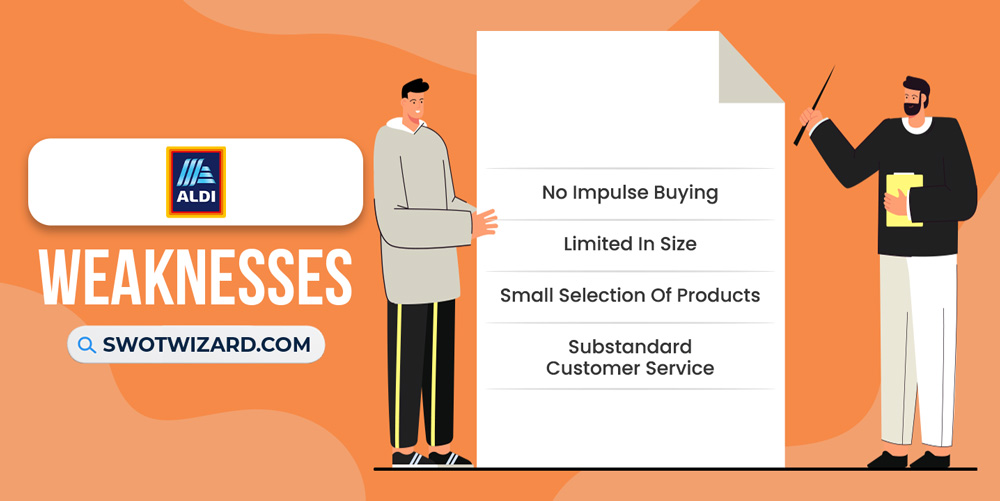
No Impulse Buying: Despite smaller-sized stores bringing the company advantages, Aldi cannot leverage its store space to encourage impulse buying. While Aldi’s store space and strategies offer room for unmatched pricing, easy access, fast payment, and grouped product deals, its attempts to expedite customers’ buying experience take away from these advantages. And due to the smaller size, private labels, frugality, and sparse in-store marketing, Aldi cannot use product positioning, color, attractive packaging, seasonal promotions, or discount deals as effectively as its competitors.
Limited In Size: Aldi’s pursuit of efficiency is greatly aided by its 12,000 square foot shops, but its business strategies also limit the company from opening supersized shops. Supersized shops or supermarkets can handle more traffic and have more products on display, in-store marketing to entice customers, and room for more stock. Supermarkets or stores can increase their sales through strategies that encourage impulse buying and upselling, such as Walmart’s rollback offers, store special announcements, and action alley. However, Aldi can never have these advantages as a larger shop would hinder its focus on efficiency.
Small Selection Of Products: Aldi’s collection of products is quite small, as most of its products are private labels produced by its suppliers. Aldi offers 15 categories of products, including dairy and eggs, fresh groceries, fresh meat and seafood, baked goods, and more. However, it offers only 76 subcategories in total, and most only contains a single product representing each item, whereas competitors can carry over 160 name brands with over 100,000 SKUs.
Substandard Customer Service: A large percentage of Aldi’s success is due to the company extending a margin of its supply chain’s savings to its customers without compromising on quality. Part of the compromise is keeping the involvement of a workforce to a minimum, thereby worsening customer service. Complaints about product quality, broken equipment, and rude staff go mostly unheeded, with only 9% of 226 logged reports resolved. In another case, 37% of the reviews of Aldi were 5 stars, but 32% of the reviews were 1 star, creating a polarizing image of the company.
Opportunities – Aldi SWOT Analysis

Exploiting The Falling US Economy: Since the advent of the pandemic, multiple global political unrests have negatively impacted the US economy. The average consumer purchasing power is now at 33.20, compared to 39.00 in May 2019. The rate of loss of purchasing power has averaged 3.08%, but the rate of loss from last year is 5.68%. Aldi can take this opportunity to aggressively expand and add new customers looking for low prices and value to its customer base.
Selling Private Labels in Asia: Other than its 22 stores in China, Aldi has not expanded into the Asian market at all. Since 2020, other than India and the Philippines, Asian countries have seen an overall decline in their disposable personal income by up to 7.3%. Asian customers are typically enthused about bargain hunts and driven by the sunk cost effect. So, even if Aldi doesn’t expand physically to Asian countries, it can have a large population as prospective customers if it sells its private labels through local channels.
Full Automation: Like Amazon Go, Aldi can use a combination of sensors, cameras, computer vision algorithms, and a phone app to create a fully automated store. Amazon Go in Seattle is only 1,800 square feet in size, suiting the small store style of Aldi. Choosing automation can allow Aldi to fully eliminate its labor costs, lowering the price even further.
Threats – Aldi SWOT Analysis

Local Competition: While Aldi has one of the lowest prices out of chain grocers, it cannot beat the quality and price that local shops provide. Most local sellers source their products directly and have powerful connections to the community. As Aldi’s shop size is small, it competes directly with these sellers and risks massive trying to enter a market that is hostile to it.
Overexerting Its Workforce: Aldi cross-trains its employees so they can multitask, and it can reduce labor costs. Currently, only 22% of employees have cited their work experience as negative, and most consider the workload average. But to keep up in the price war, Aldi may have to squeeze more performance out of its workforce or choose automation. Either option poses a risk of tarnishing its employer’s image.
Change In Consumer Trends: Customer preferences are always shifting. By going all in on efficiency, low price, and value, Aldi is risking its revenue. If the economy improves in the future, and Gen Z and Millennials lean towards extravagance in everyday products, then Aldi will struggle to maintain its market share.
[Bonus Infographic] SWOT Analysis of Aldi
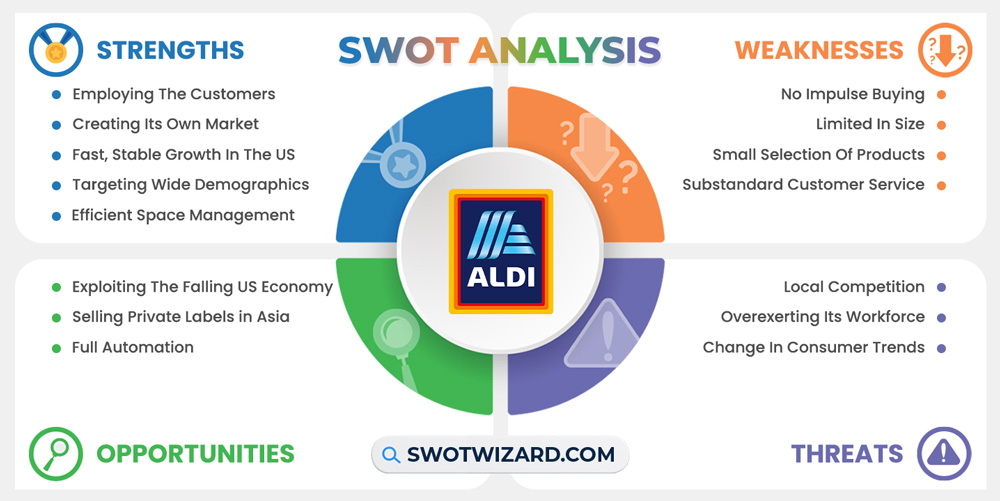
Recommendations for Aldi
Aldi can try these improvements to increase its efficiency further.
- Aldi can switch to paper packaging.
- The company can print large QR codes that can be self-scanned to checkout.
- Aldi can function as a hub for local sellers and feature their products.
- It can make B2B contracts with Asian retail giants to sell products with a long shelf-life.
- Aldi can shift its workforce to customer support after automation.
Frequently Asked Questions (FAQs)
Why is Aldi so popular?
Because Aldi offers affordable, exclusive products with excellent quality.
Why is Aldi growing so fast?
Aldi is winning ground through low operating costs, limited SKUs, and manufacturing its product lines.
Final Words on Aldi SWOT Analysis
Unlike its competitors, Aldi was born from the concept of low cost and efficiency and uses sustainability to further drive down costs. While other companies have prioritized customer experience, Aldi is overtly sacrificing convenience for value. Aldi is the perfect business for a falling economy, and it’s capable of snatching market leadership away from other giants.
References
- Wikipedia contributors. (n.d.). Aldi. Wikipedia.
- ALDI History. (n.d.). ALDI US.
- Understanding the Aldi Target Market: Who Shops There? And Why? (2022, September 30). AMPLIFY XL.
- Bose, N. (2017, May 11). Exclusive: Aldi raises stakes in U.S. price war with Wal-Mart. Reuters.
- Collins, A. (2020, May 22). We Finally Know How Aldi Keeps Their Prices So Low. The List.
- Kelly, D. (2020, December 18). The Untold Truth Of The Brothers Who Started Aldi. Mashed.
- Mehta, K. (2022, February 2). The Thrifty Business Model of Aldi. The Strategy Story.
- Aldi Demographics & Shopper Insights. (n.d.). Numerator.


